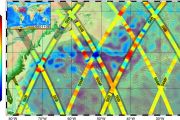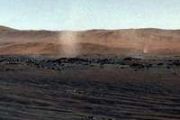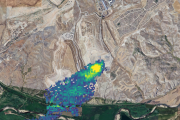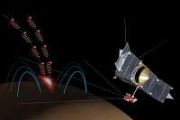
Copernical Team
Organic molecules on Mars linked to atmospheric formaldehyde
 Mars, now a cold and dry planet, once had liquid water, which raises the possibility of ancient life. In pursuit of this idea, researchers at Tohoku University developed a model showing how organic matter could have formed in Mars' ancient atmosphere.
Organic matter, which can originate from living organisms or chemical processes, contains carbon isotopes that give clues about its formatio
Mars, now a cold and dry planet, once had liquid water, which raises the possibility of ancient life. In pursuit of this idea, researchers at Tohoku University developed a model showing how organic matter could have formed in Mars' ancient atmosphere.
Organic matter, which can originate from living organisms or chemical processes, contains carbon isotopes that give clues about its formatio NASA develops process to create very accurate eclipse maps
 New NASA research reveals a process to generate extremely accurate eclipse maps, which plot the predicted path of the Moon's shadow as it crosses the face of Earth. Traditionally, eclipse calculations assume that all observers are at sea level on Earth and that the Moon is a smooth sphere that is perfectly symmetrical around its center of mass. As such, these calculations do not take into accoun
New NASA research reveals a process to generate extremely accurate eclipse maps, which plot the predicted path of the Moon's shadow as it crosses the face of Earth. Traditionally, eclipse calculations assume that all observers are at sea level on Earth and that the Moon is a smooth sphere that is perfectly symmetrical around its center of mass. As such, these calculations do not take into accoun Iridium approves $500M stock buyback, total program reaches $1.5B
 Iridium Communications Inc. (Nasdaq: IRDM), a leader in global satellite communications, has announced that its Board of Directors has authorized an additional $500 million share repurchase program, extending through December 31, 2027. This new authorization is the fourth of its kind in four years, bringing the total share buyback program to $1.5 billion. The latest authorization is the largest
Iridium Communications Inc. (Nasdaq: IRDM), a leader in global satellite communications, has announced that its Board of Directors has authorized an additional $500 million share repurchase program, extending through December 31, 2027. This new authorization is the fourth of its kind in four years, bringing the total share buyback program to $1.5 billion. The latest authorization is the largest Earth's temperature changes mapped over 485 million years
 A collaborative study by the Smithsonian and the University of Arizona provides the most detailed analysis yet of Earth's global temperature fluctuations over the last 485 million years. The research, published in 'Science' on Sept. 19, reveals a more significant variation in Earth's temperature over time than previously understood. These changes closely align with levels of carbon dioxide in th
A collaborative study by the Smithsonian and the University of Arizona provides the most detailed analysis yet of Earth's global temperature fluctuations over the last 485 million years. The research, published in 'Science' on Sept. 19, reveals a more significant variation in Earth's temperature over time than previously understood. These changes closely align with levels of carbon dioxide in th Artemis I mission data show astronauts sent to the moon aboard Orion will be protected from radiation

According to a large team of technical and health specialists, astronauts aboard the Orion spacecraft will be well protected from radiation when the Artemis II mission travels to the moon and back next year.
In their study published in the journal Nature, the group analyzed data collected from sensors inside and outside the Orion spacecraft as it made two moon flybys in 2022. They also studied data from sensors on the spacesuits worn by two dummies that went along for the ride.
NASA plans to send four astronauts to the moon next year as part of the Artemis II mission. The astronauts will be carried to the moon in the Orion spacecraft, where they will conduct a flyby before returning to Earth.
For this new study, the research team studied data from the Artemis I mission, which conducted a similar trip with dummies instead of human astronauts.
Greek CubeSats ready for assembly

It's been just over one year since ESA placed contracts for seven Greek CubeSat missions, which aim to enhance Greece's space capabilities while providing practical benefits to citizens. These CubeSats, developed by small and medium-sized companies and universities across Greece, underscore the nation's expanding space industry and its commitment to advancing space applications, such as secure optical and radio frequency (RF) connectivity, IoT communications, earth observation and RF spectrum monitoring. The missions are a collaboration of scientists, engineers and space industry partners from across Greece.
Arctic Weather Satellite’s first images capture Storm Boris

Just a month after its launch, ESA’s Arctic Weather Satellite has already delivered its first images, notably capturing Storm Boris, which has been wreaking havoc across central Europe.
SoftBank and Intelsat Partner to Develop Global 5G-Satellite Hybrid Network
 SoftBank and Intelsat have entered into a major collaboration that will create a "Ubiquitous Network," enabling continuous connectivity across the globe. Together, they will lead research and development aimed at integrating 5G terrestrial mobile networks with satellite communication systems.
In today's world, connectivity is critical, especially as technologies like autonomous vehicles an
SoftBank and Intelsat have entered into a major collaboration that will create a "Ubiquitous Network," enabling continuous connectivity across the globe. Together, they will lead research and development aimed at integrating 5G terrestrial mobile networks with satellite communication systems.
In today's world, connectivity is critical, especially as technologies like autonomous vehicles an NASA transport nearly complete for Roman Space Telescope deployment
 NASA has finished building its spacecraft bus to deploy the Nancy Grace Roman Space Telescope into orbit after the space agency finishes installing its scientific instruments and the telescope.
"They call it a spacecraft bus for a reason," said Jackie Townsend, deputy project manager for the Roman Telescope. "It gets the telescope to where it needs to be in space."
Townsend said
NASA has finished building its spacecraft bus to deploy the Nancy Grace Roman Space Telescope into orbit after the space agency finishes installing its scientific instruments and the telescope.
"They call it a spacecraft bus for a reason," said Jackie Townsend, deputy project manager for the Roman Telescope. "It gets the telescope to where it needs to be in space."
Townsend said Widespread Water and Hydroxyl Found Across the Moon
 A recent analysis of lunar maps has revealed multiple sources of water and hydroxyl in the sunlit regions of the Moon's surface, including water-rich rocks uncovered by meteor impacts across various latitudes.
"Future astronauts may be able to find water even near the equator by exploiting these water-rich areas. Previously, it was thought that only the polar region, particularly the deepl
A recent analysis of lunar maps has revealed multiple sources of water and hydroxyl in the sunlit regions of the Moon's surface, including water-rich rocks uncovered by meteor impacts across various latitudes.
"Future astronauts may be able to find water even near the equator by exploiting these water-rich areas. Previously, it was thought that only the polar region, particularly the deepl 



























